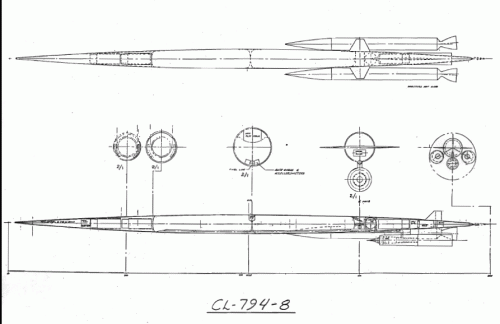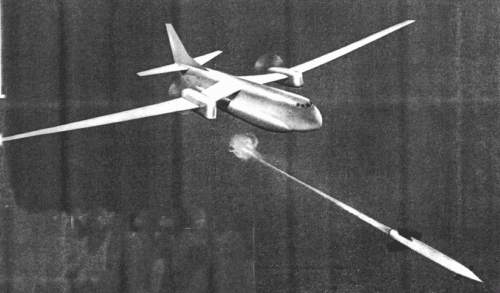- Joined
- 14 June 2006
- Messages
- 2,300
- Reaction score
- 561
I briefly mentioned before these programs in an unrelated post. Now I can offer something more substantial (it is work in progress and current research, so if someone can help, welcome).
In late 50s there was a concept for a Mobile Base Cruise (MBC) missile, studied by at least Convair San Diego, for a chemical propulsion long range cruise missile, how long, it is unknown. The concept disappears for a score of years (to our view, at least, probably there where SR-XXX type studies we don't know). In mid 1963, then, it resurfaces for two very good reasons: SLAM was on the road to cancelation, and Skybolt was already canceled. USAF was short on atmospheric backup for ICBMs and on stand-off weapons for bombers or other strategic aircrafts (missile launchers). Air Force Systems Command issued a study request for a CLAM (Chemical Low Altitude Mssile), a mid-to-long range chemical fuel cruise missile capitalizing on some of the technologies developed for SLAM (TERCOM, particularly). The specs were rather elastic and a score of companies submitted proposals (how many I've not discovered yet). What it is known that in December 1963 two companies were selected for additional nine-months studies: Lockheed California and North American (Division unknown). Slightly later (January 1964), the additional studies were reduced to a single company (CALAC) and six months duration. Nothing is known on the NAA or other companies proposals, with exception of CALAC. Lockheed assigned initially the TDN CL-794 to CLAM studies and went through 82 different iterations. Performance and characteristics varied widely, reflecting the elastic specs: expected range was 50 to 1500 nautical miles, max speed at low level from Mach 2 to 4, launch form a large aircraft or from ground (presumably mobile) base; fixed or ejectables warhead(s); single or multiple body (stages). Only drawing I have depicts CL-794-8, that seems representative of the most advanced iterations: large (slightly more than 800 inches); needle-like; two detachable solid booster for acceleration; a pod mounted ramjet (or turbo-ramjet) with a supersonic conical shock inlet; apparently three, ejectable, warheads, two in the nose and one in the tail (probably ejected in an order apt to not upset the COG and COP considering the empting of the fuel tanks ). CALAC assigned TDN CL-889 to a CLAM engine test vehicle in 1964, probably during the follow-on studies, and TDN CL-914 to CLAM optimization studies for SAC (operational use studies). TDN CL-935, covering Missile Application Propulsion Studies was also linked to the CLAM effort, which was rather vast.
My guess is that CLAM was intended as a prospective weapon for the very large very long endurance chemical propulsion missile carriers USAF and DOD were considering since at least 1960, and known under the code names Dromedary and Maple (there were studies for interim missile carriers, even a P-3 Orion modified to carry Hound Dogs in 1963). During the Fiscal 1964 USAF and DOD personnel cited long endurance missile carriers as armed with air-breathing (i.e. cruise) as opposed to ballistic (as Skybolt) missiles, and I'd bet that they were thinking of some version of CLAM. The missile carrier concept drawing published in AW&ST in that time-frame depicts the aircraft launching a very slender cruise-missile.
Besides these monsters, Lockheed assigned still in 1963 TDN CL-851 to a "small" CLAM. Apparently, this gave rise to another spec, for a Chemical Low Altitude Missile Puny, or CLAMP. Lockheed bidded for this too but apparently lost. Studies were assigned at least to LTV still in 1963, with consideration due to weapon integration with the contemporary the GD AMP proposal (Advanced Manned Penetrator), and Marquardt, for a ramjet-propulsion version. CLAMP was a direct precursor of "modern" cruise missile, even though it was supersonic. Probably it was a precursor of SRAM, too, via the little known LASRM program of mid-to-late 1964 on. LASRM saw CALAC once again involved, and used a Marquardt ramjet for propulsion (SRAM used a solid motor). More on LASRM in a different post.
In late 50s there was a concept for a Mobile Base Cruise (MBC) missile, studied by at least Convair San Diego, for a chemical propulsion long range cruise missile, how long, it is unknown. The concept disappears for a score of years (to our view, at least, probably there where SR-XXX type studies we don't know). In mid 1963, then, it resurfaces for two very good reasons: SLAM was on the road to cancelation, and Skybolt was already canceled. USAF was short on atmospheric backup for ICBMs and on stand-off weapons for bombers or other strategic aircrafts (missile launchers). Air Force Systems Command issued a study request for a CLAM (Chemical Low Altitude Mssile), a mid-to-long range chemical fuel cruise missile capitalizing on some of the technologies developed for SLAM (TERCOM, particularly). The specs were rather elastic and a score of companies submitted proposals (how many I've not discovered yet). What it is known that in December 1963 two companies were selected for additional nine-months studies: Lockheed California and North American (Division unknown). Slightly later (January 1964), the additional studies were reduced to a single company (CALAC) and six months duration. Nothing is known on the NAA or other companies proposals, with exception of CALAC. Lockheed assigned initially the TDN CL-794 to CLAM studies and went through 82 different iterations. Performance and characteristics varied widely, reflecting the elastic specs: expected range was 50 to 1500 nautical miles, max speed at low level from Mach 2 to 4, launch form a large aircraft or from ground (presumably mobile) base; fixed or ejectables warhead(s); single or multiple body (stages). Only drawing I have depicts CL-794-8, that seems representative of the most advanced iterations: large (slightly more than 800 inches); needle-like; two detachable solid booster for acceleration; a pod mounted ramjet (or turbo-ramjet) with a supersonic conical shock inlet; apparently three, ejectable, warheads, two in the nose and one in the tail (probably ejected in an order apt to not upset the COG and COP considering the empting of the fuel tanks ). CALAC assigned TDN CL-889 to a CLAM engine test vehicle in 1964, probably during the follow-on studies, and TDN CL-914 to CLAM optimization studies for SAC (operational use studies). TDN CL-935, covering Missile Application Propulsion Studies was also linked to the CLAM effort, which was rather vast.
My guess is that CLAM was intended as a prospective weapon for the very large very long endurance chemical propulsion missile carriers USAF and DOD were considering since at least 1960, and known under the code names Dromedary and Maple (there were studies for interim missile carriers, even a P-3 Orion modified to carry Hound Dogs in 1963). During the Fiscal 1964 USAF and DOD personnel cited long endurance missile carriers as armed with air-breathing (i.e. cruise) as opposed to ballistic (as Skybolt) missiles, and I'd bet that they were thinking of some version of CLAM. The missile carrier concept drawing published in AW&ST in that time-frame depicts the aircraft launching a very slender cruise-missile.
Besides these monsters, Lockheed assigned still in 1963 TDN CL-851 to a "small" CLAM. Apparently, this gave rise to another spec, for a Chemical Low Altitude Missile Puny, or CLAMP. Lockheed bidded for this too but apparently lost. Studies were assigned at least to LTV still in 1963, with consideration due to weapon integration with the contemporary the GD AMP proposal (Advanced Manned Penetrator), and Marquardt, for a ramjet-propulsion version. CLAMP was a direct precursor of "modern" cruise missile, even though it was supersonic. Probably it was a precursor of SRAM, too, via the little known LASRM program of mid-to-late 1964 on. LASRM saw CALAC once again involved, and used a Marquardt ramjet for propulsion (SRAM used a solid motor). More on LASRM in a different post.


